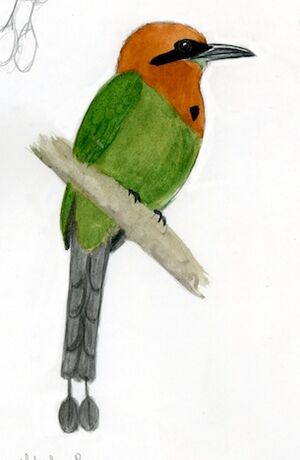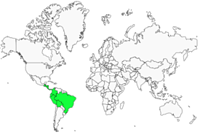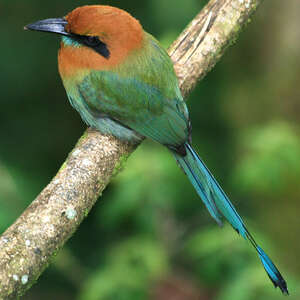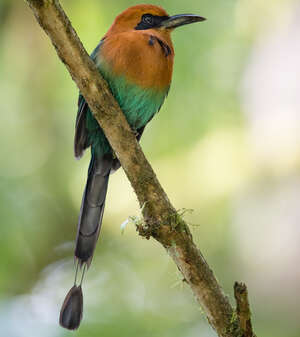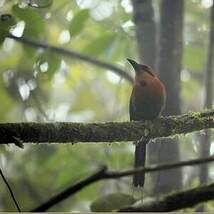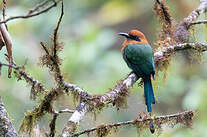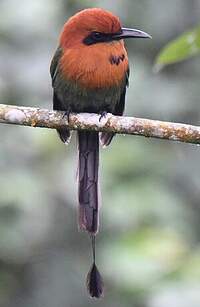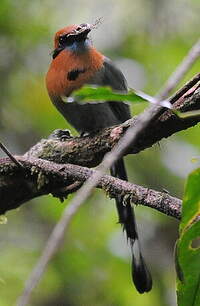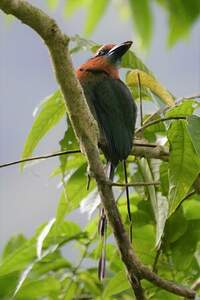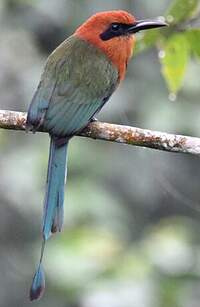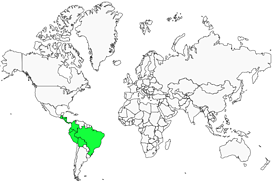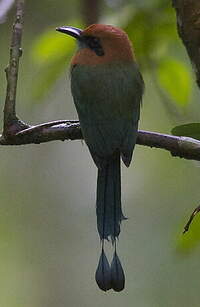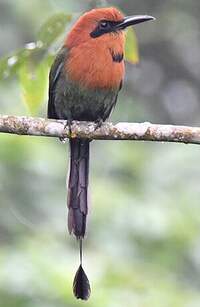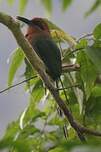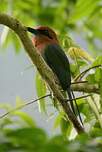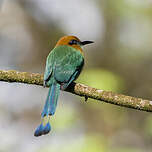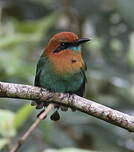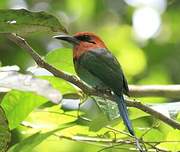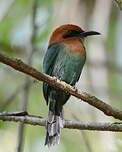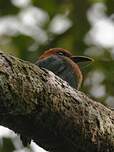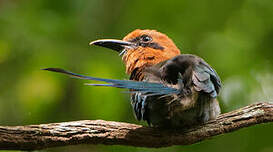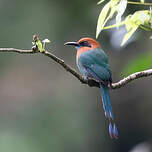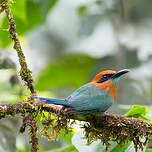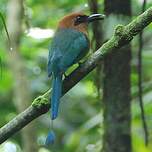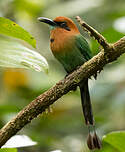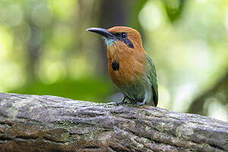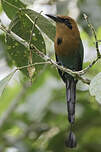Broad-billed Motmot
Electron platyrhynchum - Motmot à bec large
Identification
Broad-billed Motmot, here is a very learned name for our wide-billed motmot! The scientific name found by English ornithologist and taxidermist Benjamin Leadbeater (1760-1837) is a two-word description of our bird: golden amber with a wide bill could be the literal translation of the scientific name. It should be noted that among the six recognized subspecies, ssp Colombianum was discovered late by American ornithologist Rodolphe Meyer de Schauensee (1901-1984) in 1950. The Broad-billed Motmot is of medium size for a Motmot, 31-39 cm, the black bill is long, strong and of course wide, like many momotids, it is also serrated. The head is big, in proportion to the body, brown-red in color, the black loral line is wide and covers almost the entire eye socket, it extends behind the eye, giving the bird a masked appearance. The iris is dark brown, almost black, the neck brown-red in contrast to the green back, the green coverts a little darker than the back. The chin is blue-green while the chest retains the same brown-red color of the head and the Broad-billed Motmot shows two black eye-shaped spots on its chest, a distinctive mark of the majority of Motmots. The upper part of the abdomen is green and becomes rather blue-turquoise towards the lower abdomen. The tail is green to blue-green, ending with two racquets about 2 cm in diameter crossed with a black line at their extremity. Some birds may present only one racquet, or none at all, this absence may be due to mating or wear. There is no dimorphism, juveniles are generally darker in tone, the beautiful brown-red color is more a mix of brown and green-olive and a thin blue line above the eye appears, disappearing with age.The Broad-billed Motmot can often be mistaken for the Rufous Motmot, with which it shares the same habitat. Differentiating between them can sometimes be difficult, since the Broad-billed Motmot is usually smaller. The blue-green spot beneath its chin easily distinguishes it from the Rufous Motmot, which has a reddish chin. Six subspecies are recognized: ssp. platyrhynchum, which gives its name to the species; ssp. minor, with a duller coloration; ssp. colombianum, which has a larger blue-turquoise mark on the chin and throat, and has a smaller bill; ssp. pyrrholaemum, which is dark brown on its head and chest, and has a larger blue-turquoise mark on the chin and throat; ssp. orienticola, which is paler than platyrhynchum; and ssp. chlorophrys, which has slight yellow-green eyebrow marks.
Subspecific information 6 subspecies
- Electron platyrhynchum platyrhynchum (nw Colombia to sw Ecuador)
- Electron platyrhynchum minus (e Honduras to n Colombia)
- Electron platyrhynchum colombianum (n Colombia)
- Electron platyrhynchum pyrrholaemum (e Colombia, e Ecuador, e Peru and n Bolivia)
- Electron platyrhynchum orienticola (w Brazil)
- Electron platyrhynchum chlorophrys (c Brazil)
Foreign names
- Motmot à bec large,
- Momoto picoancho,
- udu-de-bico-largo,
- Plattschnabelmotmot,
- laposcsőrű motmot,
- Breedsnavelmotmot,
- Motmot beccolargo,
- brednäbbad motmot,
- Brednebbmotmot,
- momot širokozobý,
- momot širokozobý,
- Brednæbbet Motmot,
- leveänokkamomotti,
- motmot becample,
- piłodziób szerokodzioby,
- širokokljuni motmot,
- Плоскоклювый электрон,
- ヒロハシハチクイモドキ,
- 阔嘴翠鴗,
- 闊嘴翠鴗,
Voice song and cries
You can't necessarily talk about singing when referring to the Broad-billed Motmot, as it generally produces a croak-like sound like cwaah or cwaahnk, which is quite deep and ventriloquial. The sound is repeated at regular intervals. This call or cry is often heard at dawn, though the bird can be heard during the day too.
Habitat
Dietfeeding habits
An omnivorous large insectivore, the Broad-billed Motmot enjoys all types of insects and their larvae, spiders, and other arthropods, but also small amphibians and lizards.
It is known to hunt large (up to 25 mm) poisonous ants such as Paraponera and follow what the anglo-saxons call 'ant armies', long colonies of ants to capture their prey! Generally, it hunts from a perch, but it can be seen on the ground as well; it occasionally varies its menu with fruit, which only represent a very small part of its diet.Reproduction nesting
The breeding season is from February to May in Costa Rica, with juveniles observed in Colombia in March. Some observations have been conducted in Costa Rica; the nest is dug in a hillside, the Broad-billed Motmot digging a one-meter-long tunnel with an 8 cm diameter. The clutch consists of 2-3 eggs which are incubated for long periods of time by both parents; the female appears to incubate for longer, often from noon until nightfall. The eggs hatch after 24-25 days.
Geographic range
Its distribution range is wide and the six subspecies are spread throughout Central and South America; ssp. minor in Honduras and east of Panama; ssp. platyrhynchum west of the Andes, from northwestern Colombia to southwestern Ecuador; ssp. colombianum in the north of Colombia; ssp. pyrrholaemum east of the Andes from south of Colombia to the east of Ecuador, Peru and also in Bolivia; ssp. orienticola in Brazil in the western part of the Amazon; ssp. chlorophrys rather in the south of the Brazilian Amazon and in the Mato Grosso.
Threats - protection
IUCN conservation status
concern
in the Wild
threatened
evaluated
LC is not currently in danger, but deforestation is destroying its habitat. According to Birdlife, this deforestation is causing a loss of 13-14% of its habitat over three generations (about 11 years), leading to a reduction of 25% in population during this time. The Broad-billed Motmot is starting to decline to the west of the Equator and the Brazilian population is beginning to fragment.
Sources of information
- IOC World Bird List (v14.1), Gill, F and D Donsker (Eds). 2024-04-18.
- A Field Guide to the Birds of Brazil, Ber Van Perlo
- Scientific Birds Names, James A.Jobling
- The Birds of Panama, George R.Anger Robert Dean
- Vol. 6 - Handbook of the Birds of the World, Josep del Hoyo-Andrew Elliott-Jordi Sargatal
- xeno-canto, Sharing bird sounds from around the world,
- BirdLife International, BirdLife International
- HBW Alive,
- Wikipédia, Wikipedia, The Free Encyclopedia
- The internet Bird Collection,
Other sources of interest
 Specification sheet created on
31/07/2023 by Anne et Gabriel Leboff
Specification sheet created on
31/07/2023 by Anne et Gabriel LeboffTranslation by AI Oiseaux.net
published: 09-02-2014 - Updated: 07-05-2014
© 1996-2024 Oiseaux.net
- Accipitriformes
- Aegotheliformes
- Anseriformes
- Apodiformes
- Apterygiformes
- Bucerotiformes
- Caprimulgiformes
- Cariamiformes
- Casuariiformes
- Charadriiformes
- Ciconiiformes
- Coliiformes
- Columbiformes
- Coraciiformes
- Cuculiformes
- Eurypygiformes
- Falconiformes
- Galliformes
- Gaviiformes
- Gruiformes
- Leptosomiformes
- Mesitornithiformes
- Musophagiformes
- Nyctibiiformes
- Opisthocomiformes
- Otidiformes
- Passeriformes
- Pelecaniformes
- Phaethontiformes
- Phoenicopteriformes
- Piciformes
- Podargiformes
- Podicipediformes
- Procellariiformes
- Psittaciformes
- Pterocliformes
- Rheiformes
- Sphenisciformes
- Steatornithiformes
- Strigiformes
- Struthioniformes
- Suliformes
- Tinamiformes
- Trogoniformes

